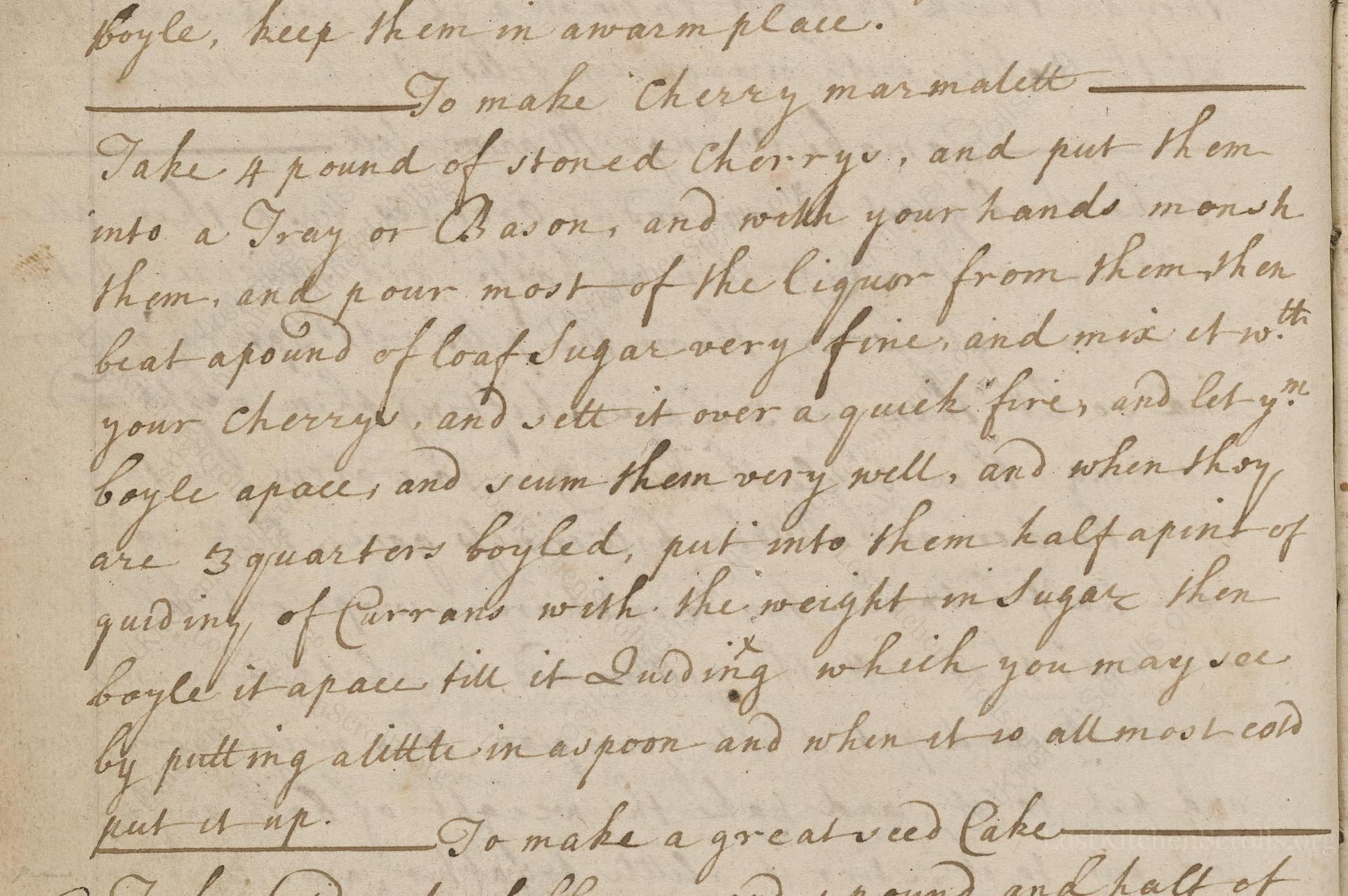
To Make Cherry Marmalett
"Take 4 pound of stoned Cherryes, and put them into a Tray or Bason, and with your hands monsh them, and pour most of the Liquor from them, then beat apound of Loaf Sugar very fine, and mix it w^{th} your Cherryes, and sett it over a quick fire, and let yo^{u} boyle apace, and scum them very well, and when they are 3 quarters boyled, put into them half apint of Guidinly of Currants with the weight in Sugar, then boylet it apace till it is Guidiny which you may see by putting a litle in aspoon, and when it is all most cold put it up."
Note on the Original Text
The recipe is written in the succinct, conversational style typical of early 18th-century English manuscript cookery, using phonetic spellings—'boyle apace', 'scum them well', and 'Guidiny' (meaning 'jellied' or set, akin to 'gelatinous'). Ingredients and instructions blend together, requiring prior kitchen experience to interpret timings and quantities. The spelling differences—'monsh' for 'mash', 'boyle' for 'boil', and 'Guidinly of Currants' likely meaning 'a guiding/jelly of currants'—reflect evolving language and lack of culinary standardization before printed cookbooks became widespread.

Title
Receipt book of Dorothy Stone (1725)
You can also click the book image above to peruse the original tome
Writer
Dorothy Stone
Era
1725
Publisher
Unknown
Background
Step into the delicious world of early 18th-century kitchens with Dorothy Stone, where classic recipes and culinary curiosities await. Expect a charming medley of hearty fare, sweet treats, and the tasteful secrets of a bygone era.
Kindly made available by
Folger Shakespeare Library
This recipe for cherry marmalade hails from around 1725, attributed to Dorothy Stone. It was composed in a time when preserving fruits was both a practical necessity and a culinary art, allowing households to enjoy seasonal flavors throughout the year. Early 18th-century England saw a surge in sugar imports, making fruit preserves more accessible. This recipe reflects the resourceful domestic cook’s methods—using hands to crush fruit, boiling over an open fire, and employing natural pectin from currants for a good set. The dish sits comfortably within the tradition of English preserves known as 'marmalett,' an older, broader term than today's narrow citrus associations.

Cooks of the time would have used a large wooden or earthenware bowl or tray to mash and mix the cherries, often by hand. A brass or copper preserving pan sat directly over a brisk wood or coal fire, with wooden spoons for stirring and skimming, and a ladle for transferring the finished marmalade to pottery jars or glass containers for storage. Testing for 'gellied' consistency was done with a metal or horn spoon, and skimming tools might have been a simple slotted spoon or even a folded piece of paper.
Prep Time
30 mins
Cook Time
20 mins
Servings
25
We've done our best to adapt this historical recipe for modern kitchens, but some details may still need refinement. We warmly welcome feedback from fellow cooks and culinary historians — your insights support the entire community!
Ingredients
- 4 lbs fresh cherries, pitted
- 1 lb granulated sugar (or loaf sugar, ground fine)
- 10 fl oz redcurrant jelly (substitute: store-bought or homemade)
- 10 oz granulated sugar (for the currants)
- Optional: additional lemon juice if needed for setting
Instructions
- Begin by taking 4 lbs of fresh cherries and remove the pits.
- Place the cherries in a large bowl or tray and mash them thoroughly with your hands.
- Pour off most of the excess juice to help achieve a thicker consistency later on.
- Add 1 lb of finely ground white sugar to the cherries and mix well.
- Transfer the mixture to a heavy saucepan and set over high heat.
- Bring it to a rapid boil, skimming off any foam that rises to the top.
- Once the cherry mixture has boiled strongly for about three-quarters of the total cooking time—roughly 15 to 20 minutes—add 10 fl oz of well-cooked redcurrant jelly along with 10 oz of sugar (to match the “weight in sugar” phrase from the recipe).
- Continue to boil briskly, stirring frequently, until the marmalade reaches a gel-like consistency (test by dropping a little on a cold spoon; if it wrinkles slightly, it’s ready).
- Once done, let the marmalade stand until just warm, then transfer to clean jars and seal tightly.
Estimated Calories
180 per serving
Cooking Estimates
It takes about 20 minutes to cook the marmalade on the stove, and about 30 minutes to pit and mash the cherries, measure ingredients, and prepare your kitchen. Each serving is about 100 grams, and the whole recipe makes roughly 2.5 kilograms of marmalade. Each serving has about 180 calories.
As noted above, we have made our best effort to translate and adapt this historical recipe for modern kitchens, taking into account ingredients nowadays, cooking techniques, measurements, and so on. However, historical recipes often contain assumptions that require interpretation.
We'd love for anyone to help improve these adaptations. Community contributions are highly welcome. If you have suggestions, corrections, or cooking tips based on your experience with this recipe, please share them below.
Join the Discussion
Rate This Recipe
Dietary Preference
Main Ingredients
Culinary Technique

Den Bockfisch In Einer Fleisch Suppen Zu Kochen
This recipe hails from a German manuscript cookbook compiled in 1696, a time whe...

Die Grieß Nudlen Zumachen
This recipe comes from a rather mysterious manuscript cookbook, penned anonymous...

Ein Boudain
This recipe comes from an anonymous German-language manuscript cookbook from 169...

Ein Gesaltzen Citroni
This recipe, dating from 1696, comes from an extensive anonymous German cookbook...
Browse our complete collection of time-honored recipes



